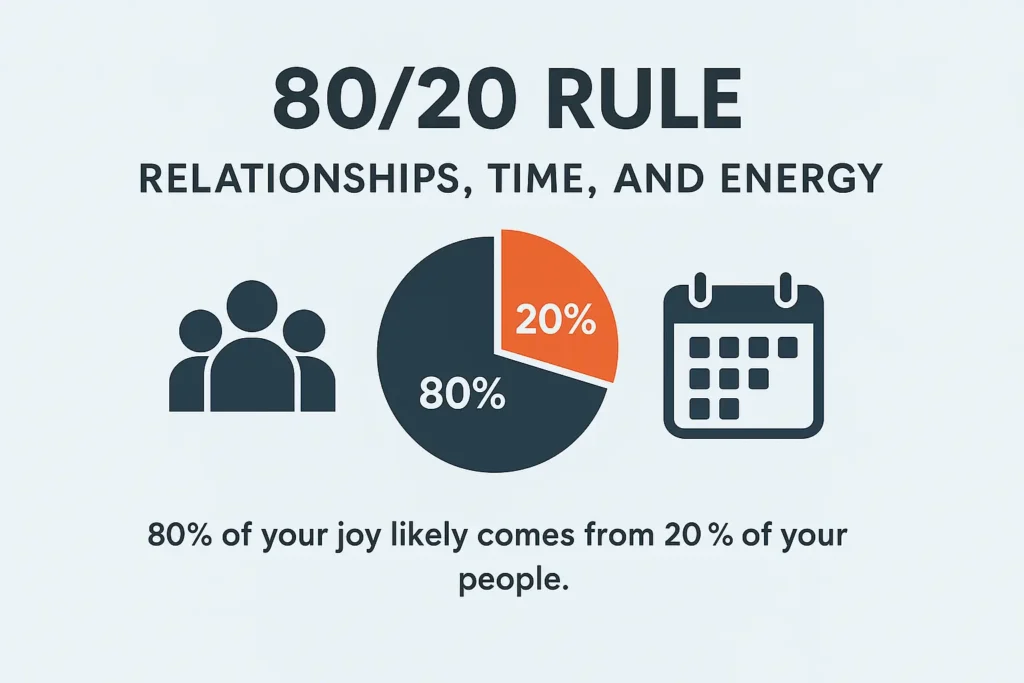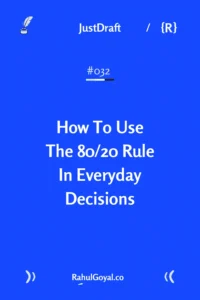The 80/20 Pareto Rule: Practical Ways To Focus On What Matters
The Pareto Principle, or the 80/20 Rule, is one of the most widely discussed concepts across business, economics, and daily life. It suggests that 80% of outcomes stem from 20% of causes.
But here’s where people get it wrong. It’s not about skipping the 80%. It’s about starting with the 20% that matters most.
While its applications are vast, let’s explore unique angles to rethink this principle in simple terms.
One Topic: Pareto Principle or 80/20 Rule – It’s Not About Math. It’s About Meaning
Rethink How You Use the 80/20 Rule
The rule isn’t about exact numbers; it’s about recognising imbalances. You already see it in your daily life:
- 80% of your stress comes from 20% of your tasks.
- 80% of business value often comes from 20% of products or clients.
- 20% of habits are responsible for 80% of your well-being.
So instead of trying to do everything better, try doing less better.
But here’s the twist: it’s not just about efficiency—it’s about focus. The rule teaches us to identify the “vital few” and prioritise them.
I learned this lesson the hard way long back probably 15 years ago when I was juggling 12 different projects as a fresher. After tracking my time and results for a month, I realised that just 3 of those projects were generating most of impact. Cutting back to focus deeply on those three changed everything.
Unique Applications for Pareto (80/20 Rule)
1. The Pareto Mindset in Creativity
Most creative breakthroughs come from a small fraction of ideas. Instead of chasing perfection in every project, focus on nurturing the 20% that spark innovation.
A friend who runs a design agency recently told me they now spend 80% of their brainstorming time exploring their top 3 ideas rather than spreading attention across 15 concepts. The result? Projects that once took months now launch in weeks with better client feedback.
Similarly, for creators, writers, or entrepreneurs—it means stop sweating every detail. Start nurturing the work that hits hardest. Even one high-impact article, design, or campaign can do more than ten “just okay” ones.
2. Relationships and Emotional Energy
In personal relationships, 20% of people in your life might contribute to 80% of your happiness. This principle encourages you to spend more time with those who truly matter while letting go of draining connections.
I used to say yes to every coffee meeting and networking event. Now I protect my calendar for the handful of relationships that truly energize and inspire me. The difference in my mental state has been remarkable.

3. Environmental Conservation
Pareto can guide actions for sustainability. For instance, focusing on the top 20% of industries responsible for pollution could lead to significant environmental improvements.
4. Flip It Sometimes Or Known as The Reverse Pareto
Here’s a twist: sometimes the “unseen 80%” holds opportunity.
A startup may grow by betting on a feature nobody thought was important. A forgotten customer segment might turn out loyal. Small gestures—like a thank-you note—can rebuild trust faster than any campaign. Small acts of kindness can ripple into significant social change.
So yes, prioritise the “vital few,” but don’t tune out the quiet value hidden in the background.
Do Not Misinterpret 80/20 Rule
The 80/20 Rule doesn’t mean ignoring the other 80%. For example:
- In education, focusing on key chapters for exams doesn’t mean skipping the rest entirely—they still provide context and depth.
- Similarly, businesses shouldn’t neglect smaller customers—they might hold long-term potential.
Pareto or 80/20 Rule is huge in Decision-Making
A Simple Checklist
Ask these questions when applying Pareto:
- What are the “vital few” contributors?
- Are we overinvesting in trivial many?
- What would happen if we shifted resources toward the impactful 20%?
Example: Time Management
Imagine you have ten tasks. Instead of spreading energy equally, identify two tasks that yield maximum results. This focus amplifies productivity without overworking yourself.
Pareto 80/20 TL;DR
The Pareto Principle isn’t just about numbers—it’s a philosophy for smarter living. It pushes us to focus on what truly matters while staying open to hidden gems in the overlooked 80%.
The 80/20 Rule isn’t a formula. It’s a filter. It reminds us: not everything deserves equal attention. But everything needs a moment of awareness before we decide.
So this week, double down on your 20%. You’ll feel 80% better.
P.S. If this post helped you think differently, do one thing—forward it to someone stuck in the 80%. They might thank you later.
Read last week’s JustDraft newsletter about Work Shutdown Ritual
Two Quotes
The difference between average and exceptional isn’t working harder—it’s ruthlessly eliminating everything that dilutes your focus from what truly matters.
Success leaves clues in the form of imbalance. Find where your disproportionate results are coming from, and you’ve found your path forward.
One Passage From A Book
The word priority came into the English language in the 1400s. It was singular. It meant the very first or prior thing. It stayed singular for the next five hundred years. Only in the 1900s did we pluralize the term and start talking about priorities. Illogically, we reasoned that by changing the word we could bend reality. Somehow we would now be able to have multiple “first” things. People and organizations try to do just that. They try to do everything at once and as a result don’t accomplish what matters most. What about you? Have you ever found yourself stretched too thin? Have you ever felt both overworked and underutilized? Have you ever found yourself majoring in minor activities? Do you ever feel busy but not productive?
📚 From Essentialism: The Disciplined Pursuit of Less by Greg McKeown

